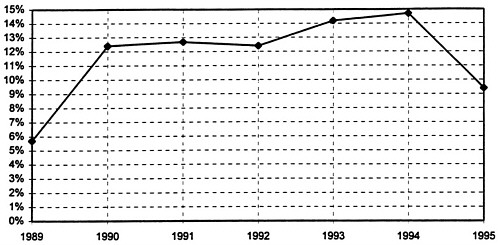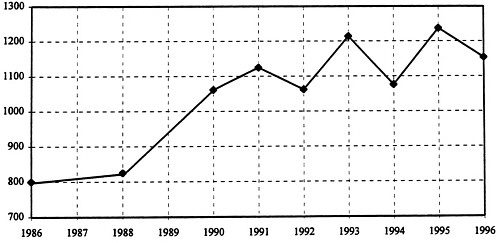5
CURRENT TRENDS
It is obvious, but should nonetheless be emphasized, that broad economic and political trends in the United States affect mathematics research. This report cannot possibly address all the complex and controversial issues concerning, for example, optimal mechanisms for federal and industrial support of research, the proper role of research universities, and the pressures of international competition. Many reports on these topics have been produced during the last few years by COSEPUP, the Office of Science and Technology Policy, the National Science Board (NSB), the Industrial Research Institute, the Council on Competitiveness, and others.
With specific reference to mathematics, the US preeminence in mathematical research, described in section 3. has been attained in large part because of the factors listed in section 4. However, unemployment among recent PhDs has created tremendous stress on US mathematics during the 1990s. In this section, we identify a variety of current trends—positive and negative— that are affecting or are likely to affect the relative position of US mathematical research in scientific accomplishments and development of the knowledge base.
5.1. Vitality of the Mathematical Sciences
The panel wishes to emphasize that US mathematical research is thriving in both quality and opportunities. Many new subfields of mathematics have been developed, and some major long-standing problems have been solved, thereby opening new avenues for solving other problems (as did Wiles's proof of Fermat's last theorem). New methods of solution have been introduced, new connections between different fields have been discovered, and new ways to apply mathematics in science and engineering have been found. Computing has transformed, and will continue to transform, all subfields of mathematics. Mathematicians worldwide express a similar level of enthusiasm for their field.
5.2. Interdisciplinary Research
Although most people agree that interdisciplinary science should be encouraged, there is no universally accepted strategy for doing so. The relative effectiveness of different approaches will be understood only after more experience is gained. In the meantime, US research mathematicians are continuing to play active—in many instances, leading —roles in interdisciplinary research. To name just one topic of current interest, mathematical research will be crucial in making sense of massive data sets (NRC 1996c), particularly when data-gathering happens adaptively in real time; lack of progress in this arena is a recognized impediment to progress in biology, medicine, astronomy, physics, and geosciences.
US universities and federal funding agencies are trying to create programs that encourage
mathematicians in all subfields to create links with other disciplines. In times of tight budgets, however, it is difficult to justify moving money away from already-squeezed disciplinary research programs that have consistently produced outstanding results. Anecdotal evidence suggests that interdisciplinary programs, especially those perceived as “risky,” are struggling to adapt within existing structures.
The United States is not alone in attempting to devise policies that support interdisciplinary science and engineering despite budget pressures. The European Union and other Europe-wide programs explicitly seek to improve scientific cooperation among the countries of the region. To prepare scientists for international work, increasing mobility of faculty and students is being encouraged. Thus, the mobility of scientists in Europe might soon rival that of scientists in the United States, previously one of the strongest qualities of the US research enterprise (see section 4.1).
Individual European countries are spending considerable sums to support interdisciplinary research. For example, the German government has begun experimental programs to increase interdisciplinary training and prepare scientists for nonacademic employment (NSF 1996c, p. 28). In France, megaprojects “grands programmes” with multiyear funding have been financed by the government in fields of scientific priority, and the National Committee for Scientific Research is vigorously supporting collaborative projects in materials science, nanotechnology, and the environment (NSF 1996c, p. 36).
5.3. Employment Prospects for New PhDs
5.3.1. Academic Jobs
Many US universities have experienced severe financial crises during the 1990s for a variety of reasons, such as the general “downsizing ” trend in the US economy and lower-than-expected undergraduate enrollments. The consequent unfavorable job market for recent PhDs in science has been discussed in detail in several reports (for example, NSF 1996b, COSEPUP 1995), but no consensus has emerged about ways to solve or even alleviate the unemployment and underemployment of PhDs.
These developments have, not surprisingly, affected mathematics, inasmuch as higher education is the largest US sector that employs mathematics PhDs. (In 1993, jobs in universities and 4-year colleges accounted for 65.2% of all employed US doctoral recipients in the mathematical sciences, followed by 24.8% in private industry and 4.5% in government) (NSF 1996c, table 20). Figure 2 depicts the unemployment rate among new PhDs in mathematics from 1989 to 1995.
The most-prominent reason for the sudden worsening of the job market in 1990 is obvious: an oversupply of new PhDs relative to the availability of tenure-track positions in colleges and universities. The number of PhDs produced by US mathematics departments began to increase in the middle 1980s, rose during the early 1990s, and has shown signs of instability recently, as shown in figure 3 (see section 5.5).
During the same period, the number of academic positions open to new PhDs in mathematics has been shrinking. From 1989 to 1994, the number of positions offered in US mathematics departments to new PhDs fell by 33%; from 1995 to 1996, there was a 6% drop in the number of new PhDs employed by US academic institutions (Davis 1997). During 1994-1995, there were 240 tenure-track positions for new doctoral recipients in US doctorate-granting departments in the mathematical sciences and 184 non-tenure-track positions.
Beyond the diminishing number of academic jobs for new PhDs lies a phenomenon that seems particularly prevalent in US mathematics: a growth in nonpermanent positions. In 1994-95, temporary positions accounted for 50% of the openings for new PhDs in doctorate-granting departments of mathematics. In the autumn of 1996, 64% of the 256 new PhDs who found jobs in academic institutions were in non-tenure-track positions; of those employed in doctorate-granting departments, 84.2% were in non-tenure-track jobs. Overall, the number of full-time US faculty not eligible for tenure rose by 29% from 1991 to 1995.
The existence of an underclass of PhDs who continue to work from year to year at low wages in nonpermanent jobs has led to frustration among recent PhDs (Davis 1997). There has been some recent growth in the number of postdoctoral positions, alleviating unemployment and at the same time providing much further training for fresh PhDs. The law abolishing retirement at a fixed age, which recently began affecting those in academic positions, might further diminish the number of job openings. Most other countries have a fixed retirement age. The pressure on the concept of tenure is likely to increase. Data on the employment situation in other countries are unavailable, but anecdotal information indicates that the problems experienced here in the academic job market are also occurring in other countries.
5.3.2 Industrial Jobs
The industrial employment market presents a mixed picture. As shown in figure 4, industrial employment of mathematicians has been increasing. But general trends in industrial research indicate a decrease in spending. Since 1988, industrial spending on research and development in the United States has not increased substantially in constant dollars. In addition, less and less is spent on longer-term research; basic research constituted 6% of industrial expenditures for research and development in 1988 and 2% in 1993 (Council on Competitiveness 1996). Industry's expenditures on basic research declined at an annual average constant-dollar rate of 4.6% from 1991 to 1995 (NSB 1996). In contrast, it is interesting to note, mathematics is expected to grow at both AT&T and Bell Laboratories.
The industrial-research funding picture is more optimistic outside the United States. Many European governments are actively encouraging nondefense industrial research and development; details about these trends can be found in a recent NSF report (1996c). The United States has trailed, for some time, Germany and Japan in civilian research and development as a percentage of GDP; industrial R&D expenditures have been relatively flat in the United States while growing in competitor countries (Council on Competitiveness 1996).
5.4. Foreign Graduate Students
The overall implications of foreign graduate students for US science are discussed in several recent reports, for example, by COSEPUP (1995). Detailed recent data are given by NSB (1996).
During the 1990s, mathematics has been one of the scientific fields most affected by growth in the number and proportion of US PhDs received by non-US students. As






